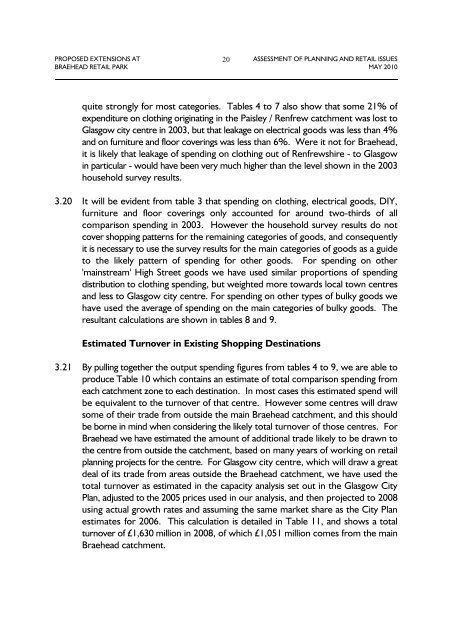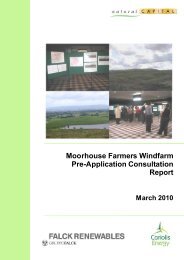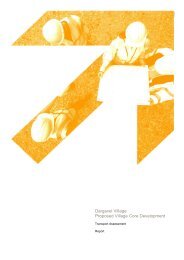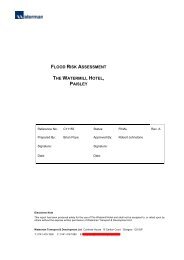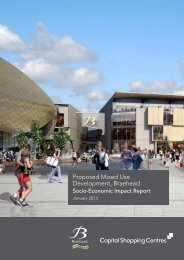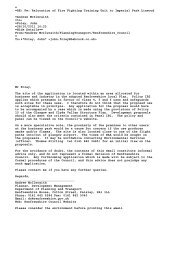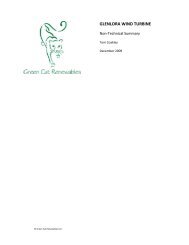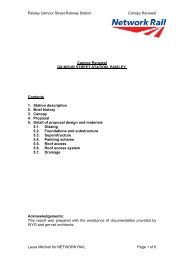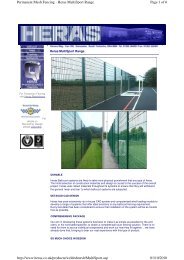Assessment of Planning and Retail Issues - Renfrewshire Council
Assessment of Planning and Retail Issues - Renfrewshire Council
Assessment of Planning and Retail Issues - Renfrewshire Council
You also want an ePaper? Increase the reach of your titles
YUMPU automatically turns print PDFs into web optimized ePapers that Google loves.
PROPOSED EXTENSIONS AT 20 ASSESSMENT OF PLANNING AND RETAIL ISSUES<br />
BRAEHEAD RETAIL PARK MAY 2010<br />
quite strongly for most categories. Tables 4 to 7 also show that some 21% <strong>of</strong><br />
expenditure on clothing originating in the Paisley / Renfrew catchment was lost to<br />
Glasgow city centre in 2003, but that leakage on electrical goods was less than 4%<br />
<strong>and</strong> on furniture <strong>and</strong> floor coverings was less than 6%. Were it not for Braehead,<br />
it is likely that leakage <strong>of</strong> spending on clothing out <strong>of</strong> <strong>Renfrewshire</strong> - to Glasgow<br />
in particular - would have been very much higher than the level shown in the 2003<br />
household survey results.<br />
3.20 It will be evident from table 3 that spending on clothing, electrical goods, DIY,<br />
furniture <strong>and</strong> floor coverings only accounted for around two-thirds <strong>of</strong> all<br />
comparison spending in 2003. However the household survey results do not<br />
cover shopping patterns for the remaining categories <strong>of</strong> goods, <strong>and</strong> consequently<br />
it is necessary to use the survey results for the main categories <strong>of</strong> goods as a guide<br />
to the likely pattern <strong>of</strong> spending for other goods. For spending on other<br />
'mainstream' High Street goods we have used similar proportions <strong>of</strong> spending<br />
distribution to clothing spending, but weighted more towards local town centres<br />
<strong>and</strong> less to Glasgow city centre. For spending on other types <strong>of</strong> bulky goods we<br />
have used the average <strong>of</strong> spending on the main categories <strong>of</strong> bulky goods. The<br />
resultant calculations are shown in tables 8 <strong>and</strong> 9.<br />
Estimated Turnover in Existing Shopping Destinations<br />
3.21 By pulling together the output spending figures from tables 4 to 9, we are able to<br />
produce Table 10 which contains an estimate <strong>of</strong> total comparison spending from<br />
each catchment zone to each destination. In most cases this estimated spend will<br />
be equivalent to the turnover <strong>of</strong> that centre. However some centres will draw<br />
some <strong>of</strong> their trade from outside the main Braehead catchment, <strong>and</strong> this should<br />
be borne in mind when considering the likely total turnover <strong>of</strong> those centres. For<br />
Braehead we have estimated the amount <strong>of</strong> additional trade likely to be drawn to<br />
the centre from outside the catchment, based on many years <strong>of</strong> working on retail<br />
planning projects for the centre. For Glasgow city centre, which will draw a great<br />
deal <strong>of</strong> its trade from areas outside the Braehead catchment, we have used the<br />
total turnover as estimated in the capacity analysis set out in the Glasgow City<br />
Plan, adjusted to the 2005 prices used in our analysis, <strong>and</strong> then projected to 2008<br />
using actual growth rates <strong>and</strong> assuming the same market share as the City Plan<br />
estimates for 2006. This calculation is detailed in Table 11, <strong>and</strong> shows a total<br />
turnover <strong>of</strong> £1,630 million in 2008, <strong>of</strong> which £1,051 million comes from the main<br />
Braehead catchment.


